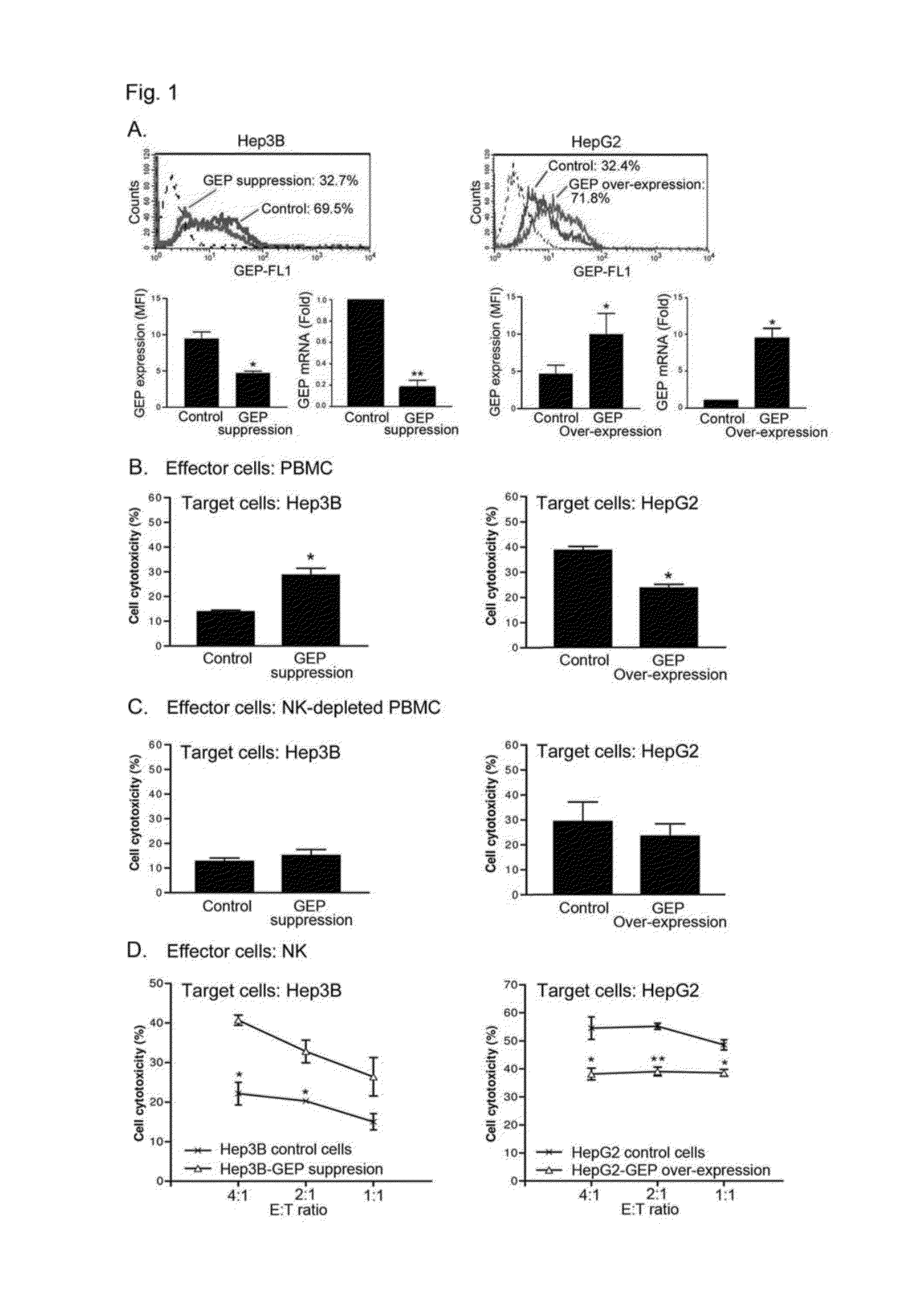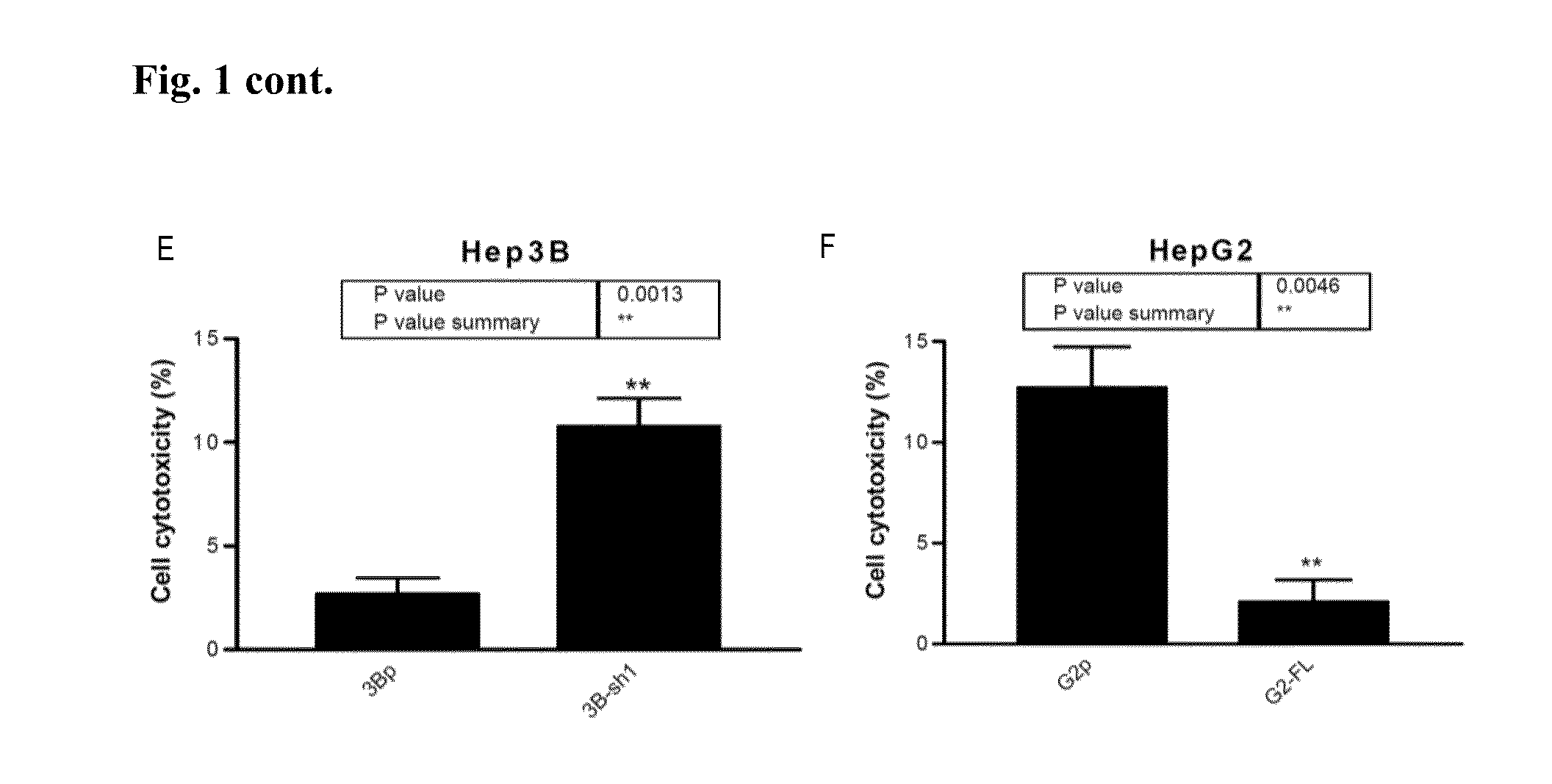Materials and methods for treatment of liver cancer
a technology for liver cancer and materials, applied in the field of materials and methods for liver cancer treatment, can solve the problems of disease recurrence, no effective treatment option for the majority of liver cancer patients, and unable to prevent curative treatment, so as to prevent or reduce the likelihood of liver tumor or cancer recurrence
- Summary
- Abstract
- Description
- Claims
- Application Information
AI Technical Summary
Benefits of technology
Problems solved by technology
Method used
Image
Examples
example 1
GEP Expression of HCC Cells Modulates Anti-Tumor Cytotoxic Activity of Immune Cells
[0137]It is postulated that only a restricted minority of tumorigenic malignant cells may possess the characteristics needed to modulate tumor-directed immune activation. To examine the effect of GEP on anti-tumor immunity, a stable transfectant of GEP suppression was established using shRNA in Hep3B, a HCC cell line with high endogenous GEP; a stable transfectant of GEP over-expression was established using GEP full-length eDNA in HepG2, a HCC cell line with low endogenous GEP level. Results from qPCR and flow cytometry showed that GEP mRNA and protein levels were significantly down-regulated in Hep3B cells, and up-regulated in HepG2 cells (FIG. 1A).
[0138]Cytotoxic activity of human PBMC against the HCC cells and their GEP transfectants was examined by dual-color flow cytometry. Cytotoxic activity of human PBMC against GEP-suppressed Hep3B cells was significantly higher than control Hep3B cells. On t...
example 2
GEP Differentially Regulates the Expression of MICA and HLA-E of HCC Cells
[0144]NK activity is regulated through integrated signaling from a panel of stimulatory and inhibitory receptors that interact with their ligands expressed on tumor cells (Lanier, L L. Annu Rev Immunol. 2005). To elucidate the mechanism for GEP-regulated NK cytotoxicity, the effect of GEP on HCC cell surface expression of ligands for both stimulatory and inhibitory receptors of NK cells was determined. MICA and HLA-A / B / C are ligands for stimulatory immunoreceptor NKG2D, and KIR2DL1 / 3DL1; while HLA-E and HLA-G are ligands for inhibiting immunoreceptor NKG2A and KIR2DL4, respectively. The surface expression of MICA, HLA-A / B / C, HLA-E, and HLA-G on Hep3B and HepG2 cells was measured, and their GEP transfectants by flow cytometry.
[0145]Upon GEP suppression, expression of surface MICA significantly increased (FIG. 2A), while surface HLA-E expression significantly decreased when compared with control Hep3B cells (FIG...
example 3
GEP Blockage by Anti-GEP Antibody A23 Modulates the Expression of MICA and HLA-E of HCC Cells
[0147]To further validate the regulatory role of GEP on the expression of MICA and HLA-E, GEP blockage by anti-GEP monoclonal antibody A23 was performed in Hep3B cells. A23, but not mouse IgG, significantly suppressed GEP expression of Hep3B cells (FIG. 3A), demonstrating the suppressing effect was specific. A23 was found to significantly increase the expression of surface MICA, while decrease soluble MICA release and surface HLA-E expression of Hep3B when compared with control and isotype control treatment (FIG. 3B).
[0148]To confirm the regulatory role of anti-GEP antibody A23 in vivo, orthotopic tumors were generated of Hep3B cells in nude mice. Tumor bearing mice were subject to saline (control) or 10 mg / kg anti-GEP antibody twice weekly for six weeks. No signs of disability and behavior abnormalities were observed during the treatment period. GEP antibody treatment was found to significa...
PUM
 Login to View More
Login to View More Abstract
Description
Claims
Application Information
 Login to View More
Login to View More - R&D
- Intellectual Property
- Life Sciences
- Materials
- Tech Scout
- Unparalleled Data Quality
- Higher Quality Content
- 60% Fewer Hallucinations
Browse by: Latest US Patents, China's latest patents, Technical Efficacy Thesaurus, Application Domain, Technology Topic, Popular Technical Reports.
© 2025 PatSnap. All rights reserved.Legal|Privacy policy|Modern Slavery Act Transparency Statement|Sitemap|About US| Contact US: help@patsnap.com



